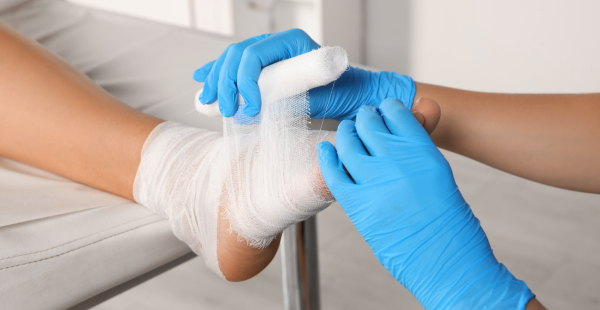The Facts
Gangrene is the death of tissue in your body. It develops when the blood supply to an affected body part is cut off because of various factors such as infection, vascular disease, or trauma. Gangrene can involve any body part, but the most commonly affected areas are the extremities (feet, arms, legs, hands).

Causes
Gas (“wet”) gangrene is the most life-threatening form of gangrene. It occurs in wounds that are infected by a family of bacteria called Clostridium. At least 20 kinds of Clostridium can cause gas gangrene. What makes the clostridia special is that they are anaerobic – that is, they grow best in the absence of oxygen. Because healthy human tissue is full of oxygen, it's rarely bothered by these bacteria. However, when they do grow, clostridia release gas and poisons into the body. This form of gangrene spreads very quickly, and can cause a rapid death.
Injuries that leave a portion of muscle tissue deprived of oxygen make an ideal home for clostridia. Some of the cells in a wound are already dead, and the infection starts in these. "Crush" injuries are most likely to cut off blood supply to a large amount of tissue, and are most prone to gangrene. The infection usually strikes the extremities, where blood supply is most easily cut off. Car accidents, for instance, often cause crush injuries to the lower legs - exactly the sort of wound that clostridia find most suitable.
Surgery can also produce areas of vulnerable tissue. Conditions favourable to clostridia are most common in people who have preexisting vascular problems, or who have many of the risk factors for heart disease. For example, high cholesterol can make blood more likely to clot. A person with high cholesterol is more likely to have more clotted blood vessels after surgery. The tissue that's normally fed by those blood vessels can run out of oxygen, allowing bacteria to multiply.
There are other causes of “wet” gangrene that aren't associated specifically with clostridia. Other bacteria such as E.coli, Klebsiella, and Proteus may cause infected “wet” gangrene in damaged tissue, resulting in a serious, often life-threatening infection.
In contrast, “dry” gangrene occurs when the blood supply to tissue is cut off but no infection develops. In these cases the tissue dies but the person generally feels well overall. Serious diseases that interfere with blood flow can cut off oxygen supply to the extremities, even when there's no trauma or injury. For example, peripheral vascular disease in which blood flow to the legs is poor can deprive a foot or leg of blood or oxygen, resulting in gangrene. People with diabetes, for instance, are prone to gangrene in the foot. Diabetes-related gangrene is the most common reason for foot amputation. Severe frostbite (due to overexposure to the cold) can also lead to gangrene due to lack of proper blood flow to the tissues.
Symptoms and Complications
Areas affected by infected or “wet” gangrene are usually warm and swollen. The skin may be pale at first, but soon turns red or brown and finally greenish-black. The affected area may become extensively scarred and require reconstructive surgery. If there is a significant amount of tissue death, the affected body part may even need to be removed.
Sometimes, a brown fluid forms under the skin, causing large skin bubbles to rise. If clostridia are the cause of the gangrene, the gas produced by the bacteria can be seen bubbling in these pockets. It often smells foul.
The substances produced by the bacteria are highly toxic to human tissue and kill cells ahead of the infection, keeping the oxygen supply low. Unless the infection is stopped, these bacterial toxins soon reach the bloodstream and begin to poison the vital organs (called toxic shock), with the kidneys failing first.
Making the Diagnosis
Gas gangrene involves a type of necrotizing (flesh-destroying) bacterial infection that a doctor can recognize. A doctor will take a tissue sample or perhaps some fluid from a skin bubble. The sample is grown in a laboratory culture to identify the bacteria. Treatment won't wait for the results to come back, however. A doctor will start giving a "broad-spectrum" antibiotic immediately.
If the infection is serious, sometimes X-rays or MRI scans are used to locate gas deep under the skin. If surgery is needed, these scans tell the doctor exactly where the bacteria are, and what needs to be removed.
Treatment and Prevention
Gangrene often spreads so quickly that it can't be stopped by antibiotics alone. Treatment consists of a three-pronged approach:
- Antibiotics help slow the infection and clear small, unnoticed pockets of bacteria.
- A surgeon debrides (cuts away) the infected flesh and a margin around it to prevent further spread. If debridement isn't enough, amputation is the next step.
- The patient is put in a hyperbaric chamber if one is available. This is a sealed metal tank pumped full of oxygen under high pressure. The pressure forces oxygen into the tissues, stopping the spread of anaerobic bacteria. Hyperbaric chambers were invented to help sea divers with the bends, but they have many uses in medicine.
Antibiotics and surgery are commonly used as the principle treatments for gangrene and have been proven to be very effective. Hyperbaric chambers aren't widely used because many hospitals don't have access to them.
With modern treatment methods, the majority of gangrene victims survive, though most lose some muscle tissue. People can reduce their chances of suffering these complications by cleaning all wounds thoroughly with antiseptic, watching for signs of pus, redness, swelling, or unusual pain, and seeing a doctor about any wound that might be infected.
All material copyright MediResource Inc. 1996 – 2025. Terms and conditions of use. The contents herein are for informational purposes only. Always seek the advice of your physician or other qualified health provider with any questions you may have regarding a medical condition. Source: www.medbroadcast.com/condition/getcondition/Gangrene



